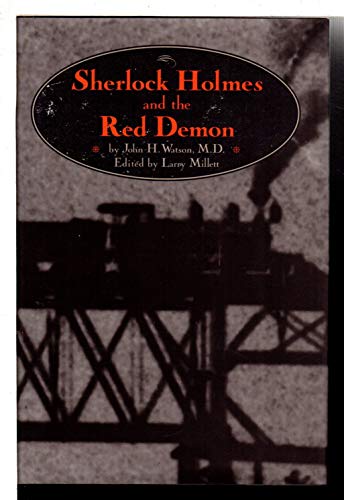Synopsis
It is the story of how the world's most beloved private detective, Sherlock Holmes, and Watson traveled to Minnesota in 1894 to find and stop a murderous arsonist, known only as the Red Demon, who is threatening both Hill and his Great Northern Railway. Homes's pursuit of this malignant and cunning villain presents the great man "with the most remarkable case of his celebrated career."
In Minnesota, Holmes comes face-to-face with all manner of frontier characters, including two-fisted railroad men, rough-and-tumble lumberjacks, a one-eyed teamster, and an unsavory town marshal. But he also encounters the proprietress of the North Woods' most opulent sporting house, Mary Robinson, a woman as clever as she is beautiful. In response to a churlish remark from Dr. Watson about the morality of her establishment, she replies: "Morality is a matter of power, nothing more and nothing less. The rich impose it on the poor, men impose it on women, and the forces of reaction impose it upon those who seek a better world."
Needless to say, Holmes becomes especially attentive to this suspect's articulate charm. But charm gives way to terror in the exciting climax of the tale, a chase on the rails that ends with Holmes and the Red Demon squared off on a lonely bridge in a fiery circle of death. "Never," says Watson, "was Holmes more magnificent than at that moment."
Reviews
Placing Sherlock Holmes in the pineries of Northern Minnesota in 1894 may not have been a three-pipe problem for Minneapolis architecture columnist Millett (Lost Twin Cities). However, there is little here but smoke and facade. The real and devastating Hinckley, Minn., fire of 1894 serves as the historical backdrop when Holmes is hired by railroad tycoon James J. Hill to find the Red Demon, the man "who is trying to burn down one of his railroads." After arriving in Hinckley to investigate, Holmes and Watson are attacked by feared logger Jean Baptiste LeGrande and rescued by Tom "Boston" Corbett, who claims to have killed John Wilkes Booth. The Town Marshall is murdered before clues lead the London duo to identify the Red Demon and the injury that motivates his actions. The final duel between Holmes and the Red Demon on a burning trestle is gripping, but this action is too little too late. Millett capitalizes on expected Sherlockian gimmicks ("parlor tricks" of deduction, hints of unrecorded grotesque cases, Holmes's masterful disguises and Watson's pomposity) but fails to probe beneath the surface of Holmes's popular image.
Copyright 1996 Reed Business Information, Inc.
An urgent, lucrative demand from railroad tycoon James J. Hill sends Sherlock Holmes and Dr. Watson to the pine forests of Minnesota, which a letter-writer calling himself the Red Demon has threatened to set afire, destroying 85 miles of Hill's Eastern Minnesota Railway along with the surrounding landscape. Once ensconced in rustic Hinckley, Holmes and Watson visit a den of iniquity called Mother Mary's, where Watson's person undergoes vile indignities at the hands of Laura and Dora, the Jack Pine Twins; outfit themselves as lumberjacks (``You look quite woodsy,'' Watson tells Holmes) in order to confront a sinister logger in the deep woods, where they're rescued by a messiah in buckskins; and try to read the clues in the disappearance of Hill's agent and the murder of the town marshal (``MARSHAL WILLIAM THOMPSON INCINERATED IN HOME--BULLET IN HIS BRAIN--FOUL PLAY SUSPECTED,'' the Hinckley Enterprise sagely reports before the Red Demon can visit a gruesome, fact-based catastrophe on the train tracks, pine trees, and citizens of Hinckley. Minnesota journalist Millett has mastered neither the cadences nor the exclusions of Watson's narrative--the story is full of tedious details Watson would have excised--but its colorful, improbable incidents and its attention to clues make it a respectable example of mid-grade Sherlockian foolery. A sequel in St. Paul is hinted. -- Copyright ©1996, Kirkus Associates, LP. All rights reserved.
"About this title" may belong to another edition of this title.
